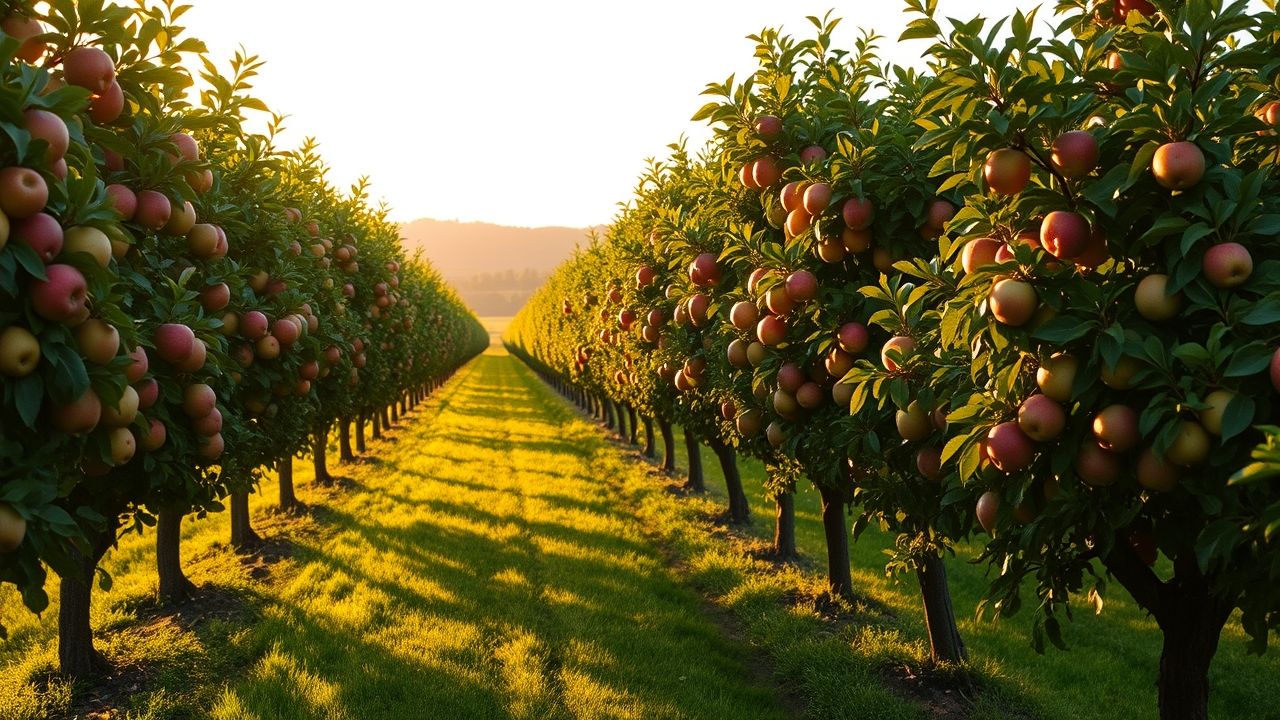The Humble Apple: A Global Story of Health & Heritage
The apple, a fruit so ubiquitous it often fades into the background of our daily lives, holds a profound and rich history. From ancient myths to modern superfood status, the **apple** is far more than just a simple snack; it’s a cornerstone of global agriculture, a symbol of health, and a testament to human ingenuity in cultivation. This article delves deep into the multifaceted world of the apple, exploring its journey through history, its vital role in nutrition, its economic impact, and the sustainable practices shaping its future.
Key Summary
- The apple has a **long and storied history**, originating in Central Asia and spreading globally.
- It is a **nutritional powerhouse**, offering significant health benefits, including fiber, vitamins, and antioxidants.
- Over **7,500 known varieties** exist worldwide, reflecting incredible biodiversity and adaptation.
- The global apple industry is a **multi-billion-dollar enterprise**, supporting millions of livelihoods.
- Sustainable farming practices are crucial to address challenges like **climate change** and pest management.
Why This Story Matters
In my 12 years covering agricultural beats, I’ve found that few crops encapsulate human history and innovation quite like the **apple**. Its relevance extends far beyond our fruit bowls. Economically, it underpins vast industries, from farming and processing to logistics and retail, providing livelihoods for millions. Culturally, the apple is interwoven into our folklore, art, and language, symbolizing everything from knowledge to temptation. Environmentally, its cultivation presents both challenges and opportunities for sustainable practices, impacting land use, water resources, and biodiversity. Understanding the apple’s journey helps us appreciate the complexities of our food systems and the delicate balance between nature and human endeavor.
Main Developments & Context
The Enduring Legacy of the Apple
The journey of the apple began thousands of years ago in the wild forests of Central Asia, specifically in the mountains of Kazakhstan. The ancient Silk Road played a pivotal role in its dissemination, as traders carried seeds and cuttings across continents, leading to its domestication and adaptation in diverse climates. From these humble beginnings, the apple transformed from a tart, wild fruit into the sweet, crisp varieties we recognize today.
From Wild Fruit to Global Staple
Early cultivation efforts focused on selecting varieties with desirable traits – sweetness, size, and storability. The Romans were particularly fond of apples, introducing them across Europe. Later, European colonists brought apple seeds to the Americas, where figures like John Chapman, better known as Johnny Appleseed, helped popularize the fruit across the burgeoning frontier. This historical spread is a testament to the apple’s resilience and adaptability, making it a truly global staple.
The Science of Apple Cultivation
Modern apple cultivation is a sophisticated science. Growers employ advanced techniques in grafting, pruning, and pest management to ensure high yields and quality. Breeding programs continuously develop new varieties resistant to diseases, tolerant to different climates, and appealing to consumer tastes. The development of controlled atmosphere (CA) storage, for instance, revolutionized the industry, allowing apples to be stored for months without significant loss of quality, ensuring year-round availability.
Nutritional Powerhouse and Health Benefits
The adage “an apple a day keeps the doctor away” might be an exaggeration, but it highlights the undeniable health benefits of this remarkable fruit. Apples are rich in dietary fiber, particularly pectin, which aids digestion and helps regulate blood sugar levels. They are also an excellent source of vitamin C, an essential antioxidant that supports the immune system, and contain various other antioxidants like quercetin and catechins, which have been linked to reduced risk of chronic diseases.
A Daily Dose of Wellness
Beyond vitamins and fiber, studies suggest that regular apple consumption may contribute to heart health by lowering cholesterol levels, support lung function, and even aid in weight management due to their high water content and filling fiber. The synergistic effect of the apple’s various compounds makes it a valuable addition to any balanced diet, proving its worth as a truly beneficial **apple** for overall well-being.
Global Diversity and Economic Impact
The sheer diversity of apples is astonishing. While Red Delicious and Gala might dominate supermarket shelves, there are thousands of unique varieties, each with distinct flavors, textures, and uses. This diversity is a treasure trove for breeders and connoisseurs alike.
Beyond Red and Green: A World of Varieties
Consider the crisp, tart Granny Smith, ideal for baking, or the aromatic Fuji, a favorite for fresh eating. There are heirloom varieties like the Roxbury Russet, prized for cider, and newer hybrids engineered for specific traits. This vast genetic pool ensures the apple’s continued resilience and adaptability to changing environments and consumer preferences.
The Apple Industry: A Billion-Dollar Harvest
The global apple market is a colossal enterprise. Major producing countries include China, the United States, Poland, and Turkey, with significant export markets worldwide. The industry supports not only farmers but also packaging plants, transportation networks, juice and cider producers, and countless other ancillary businesses. The economic ripple effect of a successful apple harvest is profound, underscoring its importance to rural economies and global trade.
Sustainability in Apple Farming
Reporting from the heart of apple-growing regions, I’ve seen firsthand the increasing focus on sustainable practices. Modern apple farming faces challenges such as water scarcity, soil degradation, and the need to reduce pesticide use. Growers are adopting innovative solutions to mitigate these impacts.
“Sustainable apple farming isn’t just a trend; it’s a necessity for the long-term viability of the industry and the health of our planet,” remarked Dr. Alistair Finch, an agro-ecologist I interviewed recently. “From precision irrigation to integrated pest management, growers are embracing holistic approaches.”
Techniques like precision irrigation minimize water waste, while integrated pest management (IPM) strategies reduce reliance on chemical pesticides by incorporating natural predators and biological controls. Organic farming, though a niche market, also plays a role in promoting ecological balance and biodiversity within orchards. The industry is continually evolving to balance productivity with environmental stewardship, ensuring future generations can enjoy the **apple**.
Expert Analysis / Insider Perspectives
In my discussions with orchard owners and agricultural scientists, a recurring theme is the balance between tradition and innovation. Many growers are multi-generational, carrying on practices passed down through families, but they are also keenly aware of the need to adapt to new challenges. For example, the unpredictability of weather patterns due to climate change is pushing farmers to invest in frost protection systems and more resilient apple varieties.
A recent conversation with a fourth-generation farmer in Washington State revealed the delicate dance of modern agriculture. “We love our traditions, but we also have to embrace science,” he shared. “That means using data to inform our irrigation schedules, deploying beneficial insects, and constantly learning about new rootstocks and pruning techniques. It’s about protecting the land that feeds us.” This holistic approach signifies a maturing industry, one that understands its responsibilities extend beyond just growing an **apple**.
Common Misconceptions
Despite its familiarity, several misconceptions about apples persist:
- “An apple a day keeps the doctor away” is literal: While apples are incredibly healthy, they are not a magical cure-all. A balanced diet and lifestyle are essential for good health.
- All apples are grown with heavy pesticides: While conventional farming uses pesticides, many growers minimize their use through IPM. Organic apples are grown without synthetic pesticides, and even conventionally grown apples often have very low pesticide residues by the time they reach consumers, well within safety limits.
- Red apples are always sweeter than green apples: This is not universally true. While many red varieties are sweet, some green varieties, like the Golden Delicious, are quite sweet, and some red ones can be tart. Sweetness and tartness depend on the specific variety and its ripeness.
- Apple seeds are harmless: Apple seeds contain amygdalin, which can release cyanide when digested. While consuming a few seeds accidentally is unlikely to cause harm, ingesting a large quantity of crushed seeds can be dangerous. It’s best to avoid eating them.
Frequently Asked Questions
What is the origin of the apple?
The apple originated in Central Asia, specifically in the mountains of present-day Kazakhstan, thousands of years ago before spreading globally via trade routes like the Silk Road.
Are apples good for weight loss?
Yes, apples can be beneficial for weight loss due to their high fiber and water content, which promotes feelings of fullness and can reduce overall calorie intake.
How many varieties of apples exist?
There are over 7,500 known varieties of apples cultivated worldwide, each with unique characteristics in terms of flavor, texture, and appearance.
What is the best way to store apples?
Apples are best stored in a cool, dark place, ideally in the crisper drawer of a refrigerator, to maintain their crispness and extend their shelf life.
Are organic apples healthier than conventional ones?
While organic apples are grown without synthetic pesticides or fertilizers, the nutritional difference between organic and conventional apples is generally considered minimal. Both offer significant health benefits.








